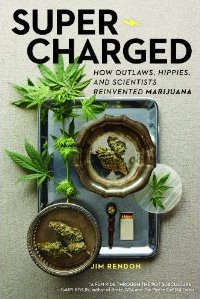Book Review : Pop Culture / Agriculture / Medicine
Super-Charged: How Outlaws, Hippies, and Scientists Reinvented Marijuana
Review by Jim Barnes, Managing Editor, www.IndependentPublisher.com
We all know marijuana is illegal in the United States, and has been since 1937. We also know that an underground resurgence of widespread use began in the sixties and has resulted in gradual decriminalization. As of today, 17 U.S. states (and D.C.) that have passed medical marijuana laws, and this November, voters in Colorado, Washington and Oregon will decide whether to legalize and tax marijuana for use by adults, the way alcohol and cigarettes are now regulated. Polls in many states show people support these reforms; in Oregon the Cannabis Tax Act would slash police and prisons by $60 million and generate $140 million in tax revenue. Sounds like a no-brainer, right?
This book helps answer that question, offering an in-depth, balanced look at the state of pot cultivation and consumption in America today. Investigative Journalist Jim Rendon has teamed up with Timber Press, one of the top U.S. agricultural publishers, to dig deep into what just a decade ago a completely underground world of growers, suppliers and users.
The book is also very timely in light of recent legal developments in California, the “poster child” of medical marijuana states. In July, the Los Angeles city council voted to shut down all 900 medical-marijuana storefronts in the city, acknowledging how out of control the sales and usage had become since the legislation passed in 1996.
Problem is, the federal law against marijuana use still on the books. Plus, there’s the issue of all that income without federal taxes being collected. And, probably most importantly, a powerful drug like the “super-charged” pot being grown today comes with plenty of abuse, crime and gang participation. As one of the owners of a large California dispensary says on the Discovery Channel television showWeed Wars, “Every day you get to walk home not in handcuffs is a good day.”
Super-charged helps sort out these issues facing the medical marijuana industry. Much of the text explains how the new laws have allowed many of the outlaw growers of the ‘60s and ‘70s to come back above ground. Author Rendon describes the carnival-like atmosphere at events like the High Times Medical Cannabis Cup in San Francisco, where if you have a physician’s recommendation (conveniently available at the fair for $60) you can buy, sell, smoke, and learn about all the latest products and techniques – in public, and in broad daylight.
Rendon also goes into great detail about the science of marijuana, and how well-funded pharmaceutical companies study the chemistry and genetics to come up with new medical uses. The UK-based GW Pharmaceuticals has spent $300 million to date, developing a treatment for involuntary muscle contraction in multiple sclerosis patients that is approved for use in Europe and Canada. Patients spray an extract under their tongue, and the therapeutic effect is delivered without making the users high. Other medical uses include relief from chronic pain, epilepsy, cancer, AIDS, and glaucoma.
A few marijuana factoids:
- A strain known as Lamb’s Bread, rumored to have been reggae legend Bob Marley’s favorite, is sold by growers to dispensaries for $3,600 per pound.
- An estimated 3 percent of California’s electrical power usage goes to indoor pot growing.
- The federal government and the DEA seized 7.3 million plants in 2010 (70 percent of them in California).
This last fact points out how marijuana is still a big part of the U.S. government’s “war on drugs” – something that could become a presidential campaign issue, in light of the recent news that President Obama has announced plans for a 50% cut to the defense department’s funding of National Guard helicopter runs responsible for the bulk of the above-mentioned plant seizures.
Will it become legal? Could it save the economy? Rendon lays out a scenario for California, comparing it to the hugely successful wine industry. If legalization resulted in 30% as much commerce as the state’s wine business, $12 to $18 billion in economic activity would occur, with 60,000 to 100,000 new jobs and $2.5 to $3.5 billion in legal wages. Now there’s a campaign promise that would attract attention.
Super-charged is the best book out there for getting up to speed on an intriguing part of our culture, and what is likely the most mysterious and powerful herb on the planet.
ISBN-10: 1604692952


